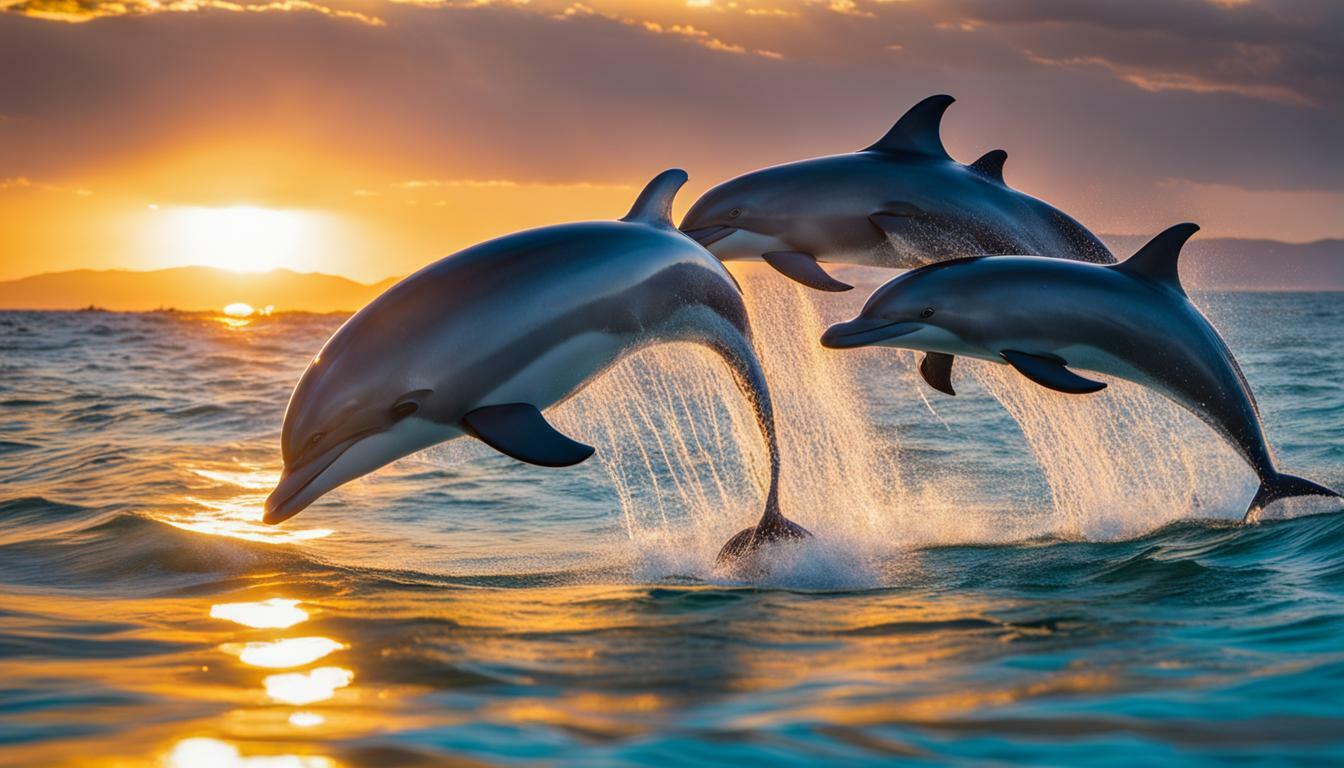Dolphins have a fascinating life span and longevity that is influenced by various factors. Understanding the lifespan of dolphins is crucial for their conservation and well-being. In this article, we will explore the average dolphin lifespan, factors that affect their longevity, and the ethical implications of keeping dolphins in captivity. Get ready to dive into the world of these incredible marine creatures and discover the secrets behind their long and remarkable lives.
Average Dolphin Lifespan and Factors Affecting It
The average lifespan of dolphins, particularly bottlenose dolphins, is influenced by various factors and can vary significantly. While some dolphins can live up to 40 years, the average lifespan of bottlenose dolphins ranges between 15 and 16 years.
Several factors can affect the life span of dolphins. Health issues, such as diseases and infections, can shorten their lifespan. Injuries, either from natural causes or human interactions, can also have a detrimental impact. Dolphins may encounter predators in their habitats, such as sharks and killer whales, which can pose a threat to their survival.
Human activity is another significant factor affecting dolphin longevity. Fishing practices, including accidental entanglement in fishing nets, can lead to injury or death. Hunting and deliberate harm caused by humans also contribute to the decline in dolphin populations and overall life expectancy.
| Factor | Impact on Dolphin Lifespan |
|---|---|
| Health Issues | Potentially shorten lifespan due to diseases and infections. |
| Injuries | Can have a detrimental impact on lifespan, both from natural causes and human interactions. |
| Predators | Poses a threat to dolphin survival, particularly sharks and killer whales. |
| Human Activity | Hunting, fishing practices, and deliberate harm can contribute to a decline in dolphin populations and overall life expectancy. |
Understanding these factors can help in implementing measures to protect dolphins and ensure their long-term survival. Conservation efforts, habitat preservation, and promoting responsible human interactions are essential for maintaining healthy dolphin populations and increasing their longevity.
Dolphins in Captivity: Survival Rates and Ethical Concerns
Dolphins in captivity have different survival rates and pose ethical questions regarding their longevity and well-being. While marine mammal parks and aquariums strive to provide suitable environments for captive dolphins, concerns have been raised about the conditions in which these animals live and the impact it has on their health.
According to research, dolphins in captivity have an annual survival rate of 0.97 and a median lifespan of 22.8 years. It’s important to note that these figures may vary depending on the specific facility and the level of care provided. For instance, the longest-lived dolphin in human care in the United States was 61 years old, a testament to the efforts made by some organizations to ensure the well-being of captive dolphins.
Marine parks and aquariums implement extensive social enrichment programs and provide high-quality food to ensure the physical and mental stimulation of the dolphins. However, concerns have been raised about certain aspects of their captivity. For example, the recent deaths of three dolphins at The Mirage casino in Las Vegas have led to scrutiny of the conditions and care provided at their animal exhibit. Inadequate shade in outdoor facilities can be detrimental to the dolphins’ health, especially in hot climates.
Ethical Implications of Captive Dolphin Programs
“The recent deaths of three dolphins at The Mirage casino in Las Vegas have raised concerns about the conditions of the animal exhibit there, as well as the ethical implications of captive dolphin programs.”
The ethical implications of keeping dolphins in captivity have been a subject of ongoing debate. While captive dolphins receive care and attention, questions arise about the moral implications of confining these highly intelligent and socially complex creatures. Advocates argue that dolphins should be allowed to live in their natural habitats, where they can freely exhibit their natural behaviors.
There is growing support for the relocation of dolphins to sanctuaries, where they can experience a better quality of life in a more natural environment. These sanctuaries aim to provide a safe and more immersive space for dolphins, allowing them to thrive in a manner that aligns more closely with their natural behaviors. The transition from captivity to sanctuaries can be a complex process, requiring careful planning and consideration of the individual needs of each dolphin.
As the conversation surrounding captive dolphin programs continues, it is essential to consider the long-term well-being and conservation of these remarkable creatures. Balancing the educational and research benefits of interaction with captive dolphins with the ethical considerations of their captivity is a challenge that demands ongoing dialogue and exploration of alternative solutions.
| Survival Rate | Median Lifespan | Oldest US Dolphin in Human Care |
|---|---|---|
| 0.97 | 22.8 years | 61 years old |
Dolphins in the Wild: Health Risks and Predators
Dolphins in the wild encounter various health risks and predators that can impact their lifespan. These intelligent marine mammals face a range of challenges in their natural habitat, from contaminated water sources to dangerous predators lurking beneath the waves. Understanding these risks is crucial to ensuring the well-being and conservation of wild dolphin populations.
Health Risks for Wild Dolphins
Wild dolphins are vulnerable to health issues that can arise from their environment. Tainted water supplies, caused by pollution and human activities, pose a significant threat. Harmful algae blooms can contaminate the water, leading to serious health problems for dolphins. In some instances, these health problems mimic those experienced by humans with diabetes, underscoring the importance of preserving clean and healthy marine ecosystems.
Additionally, dolphins can suffer from other health-related challenges, including injuries and illnesses. These can result from natural causes, such as fights with other dolphins or encounters with sharp objects, or from human activities like fishing practices that inadvertently harm dolphins. Dolphins may also find themselves stranded on beaches due to illness or injury, further endangering their well-being.
Dolphin Predators
Dolphins may be highly intelligent and agile swimmers, but they are not exempt from predation in the wild. Sharks and killer whales are among the primary predators of dolphins. These apex predators can pose a significant threat to dolphin populations, particularly to younger or weaker individuals. The struggle for survival in the face of these powerful predators adds further complexity to the challenges dolphins face in the wild.
| Health Risks for Wild Dolphins | Dolphin Predators |
|---|---|
|
|
In conclusion, wild dolphins face a variety of health risks and predators that can impact their lifespan. From contaminated water supplies to encounters with sharks and killer whales, these majestic creatures must navigate a complex web of challenges in their natural habitat. Protecting the health and well-being of dolphins and their ecosystems is essential for their future survival.
The Future of Captive Dolphins and Alternative Solutions
The future of captive dolphins is a topic of debate, with a growing focus on providing alternative solutions for their well-being and longevity. As awareness of the ethical implications of keeping dolphins in marine mammal parks and aquariums increases, there is a greater push to create dolphin sanctuaries as a more natural and humane alternative.
Dolphin sanctuaries aim to provide dolphins with a more suitable living environment, closely resembling their natural habitat. These sanctuaries offer a larger space for dolphins to swim, dive, and socialize, promoting their physical and mental well-being. They also allow for greater interaction with their own kind and the freedom to exhibit natural behaviors, essential for their overall health and longevity.
By relocating captive dolphins to sanctuaries, we can ensure that these magnificent creatures have a better quality of life. They will have access to clean and spacious habitats, and will no longer be subjected to the stress and confinement of small tanks. This shift towards sanctuary living not only benefits the dolphins, but also raises awareness about the ethical implications of keeping them in captivity.
Table: Comparison of Marine Mammal Parks and Dolphin Sanctuaries
| Criteria | Marine Mammal Parks and Aquariums | Dolphin Sanctuaries |
|---|---|---|
| Living Space | Small tanks | Large, natural habitats |
| Social Interaction | Restricted | Encouraged with other dolphins |
| Natural Behaviors | Limited | Supported and encouraged |
| Well-Being | Varies; may face inadequate shade and exhibit conditions | Enhanced physical and mental well-being |
It is important to acknowledge that there are ongoing efforts and improvements in the care and well-being of dolphins in marine mammal parks and aquariums. Many facilities provide extensive social enrichment programs and high-quality food to enhance the lives of captive dolphins. However, concerns about exhibit conditions and inadequate shade in outdoor facilities still persist.
In conclusion, the future of captive dolphins lies in the development of dolphin sanctuaries and the promotion of alternative solutions that prioritize their well-being and longevity. As we continue to learn more about these incredible creatures and their needs, it is crucial that we advocate for their rights and strive to create environments that allow them to live as naturally as possible.
Can Dolphins’ Longevity Affect Their Intelligence and Problem-Solving Abilities?
The dolphins’ problem-solving abilities are closely tied to their longevity. These intelligent creatures have been known to display remarkable problem-solving skills. With a lifespan of up to 60 years, dolphins have ample time to refine their cognitive abilities, allowing them to tackle complex tasks and exhibit high levels of intelligence. Their longevity clearly contributes to their impressive problem-solving capabilities.
What is the Natural Habitat of Dolphins and How Does it Impact Their Life Span?
Dolphins are marine mammals known for their playful nature and immense intelligence. Exploring dolphins’ deep sea habitat, we uncover their natural dwelling place: the ocean’s coastal areas and warm, tropical waters. This habitat provides them with abundant food sources and protection from predators. The habitat plays a crucial role in their life span, as it influences their access to resources and contributes to a thriving ecosystem where they can flourish.
Conclusion
In conclusion, dolphins have a unique life span and longevity, and it is crucial to prioritize their conservation and well-being to ensure their continued existence. Factual data shows that dolphins can live for decades, but their lifespan can be shortened due to various factors. The average lifespan of bottlenose dolphins is between 15 and 16 years, although some can live up to 40 years. The oldest scientifically aged dolphin in the wild was 48 years old, and the oldest dolphin in captivity was over 50.
Dolphins face health risks in both the wild and captivity. They can encounter tainted water supplies and toxic algae, which can pose serious health issues. They may also experience health problems similar to diabetes. Additionally, dolphins are preyed upon by sharks and killer whales, and can strand themselves on beaches due to illness or injury. Human activities such as fishing practices and hunting can further impact dolphin longevity.
In marine mammal parks and aquariums, dolphins have an annual survival rate of 0.97 and a median lifespan of 22.8 years. The longest lived US dolphin in human care was 61 years old. While dolphins in captivity are well cared for, with extensive social enrichment programs and high-quality food, conditions in some exhibits may be detrimental to their health. Recent incidents, such as the deaths of three dolphins at The Mirage casino in Las Vegas, have raised concerns about the conditions and ethical implications of captive dolphin programs.
The future of captive dolphins and the importance of relocating them to sanctuaries for a better quality of life are subjects of ongoing debate. It is essential to continue the conversation and actively seek alternative solutions to marine mammal parks and aquariums. By prioritizing the well-being of dolphins, we can ensure their ongoing existence and contribute to the conservation of these intelligent and remarkable creatures.










